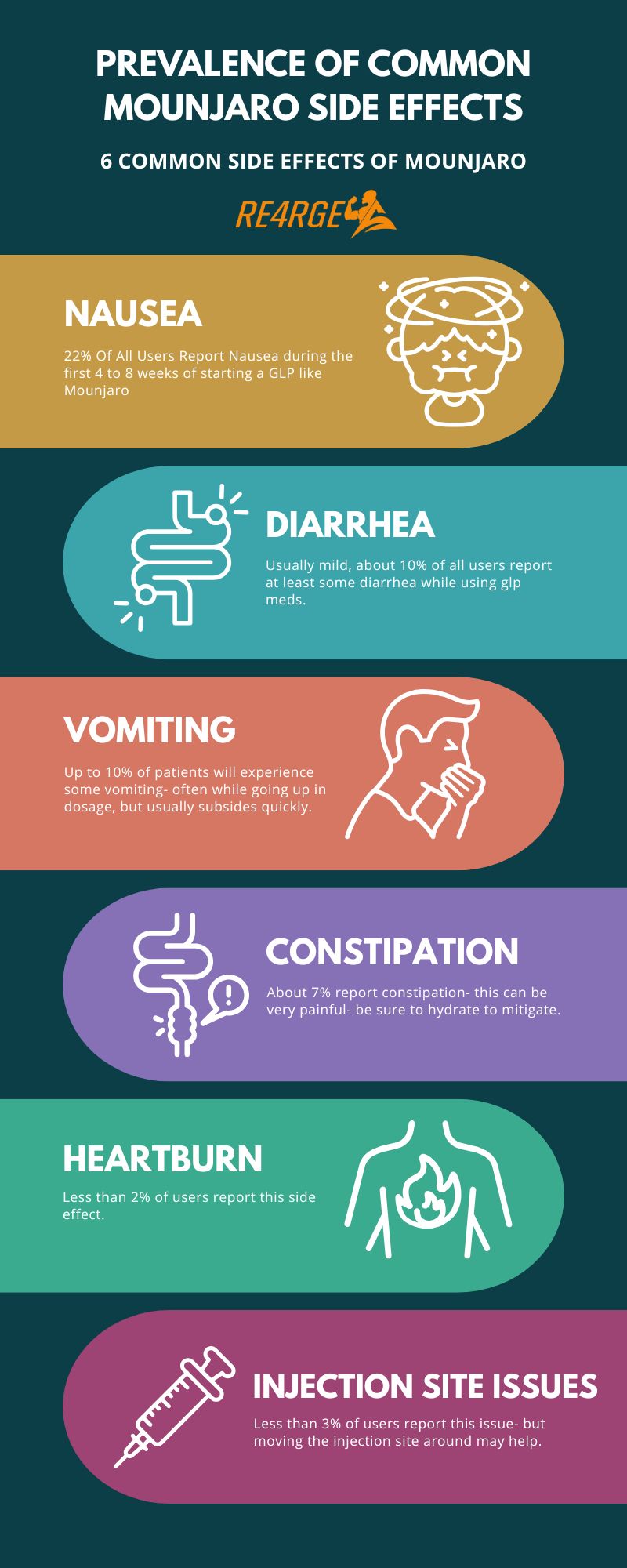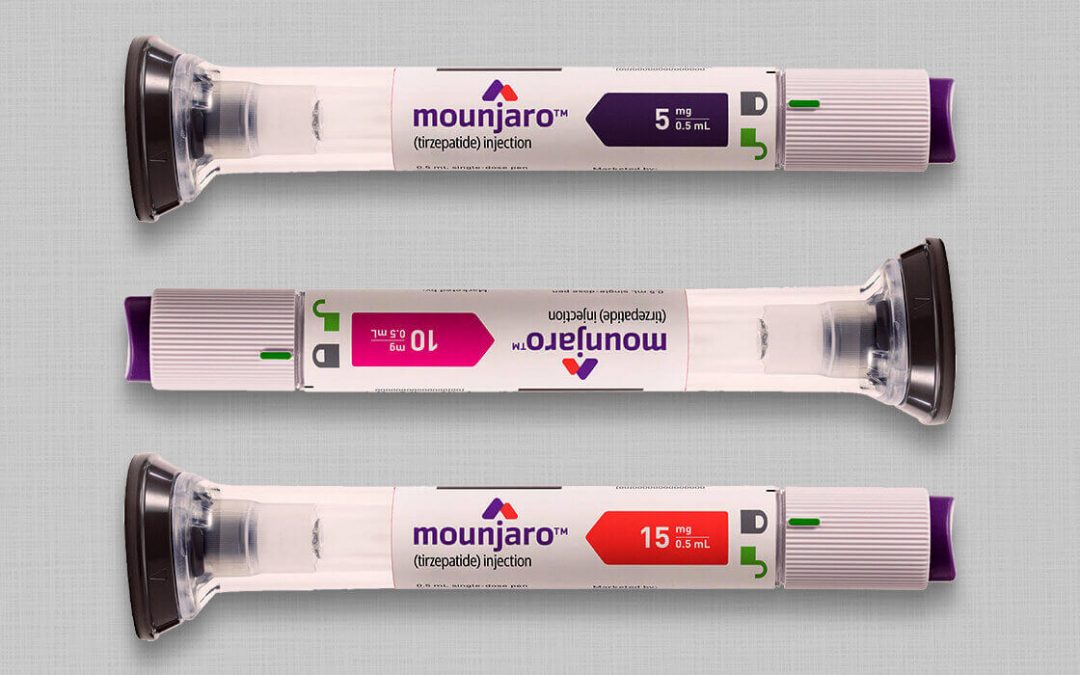Mounjaro Side Effects: What You Need to Know Before Starting Treatment
What is Mounjaro?
Common Side Effects of Mounjaro
Mounjaro’s most frequent side effects are gastrointestinal (GI), affecting up to 44% of users in clinical trials, particularly during dose escalation. These side effects are usually mild to moderate and tend to decrease over time as your body adjusts. Below are the most common side effects, based on data from Eli Lilly’s trials and the FDA’s Mounjaro label:
- Nausea: Up to 22% of users report nausea, often most intense when starting treatment or increasing doses (e.g., from 2.5 mg to 5 mg).
- Diarrhea: Affects about 1 in 10 users, typically mild but occasionally persistent.
- Vomiting: Seen in up to 10% of users, often linked to nausea or dose changes.
- Constipation: Reported by 1 in 13 users, sometimes requiring dietary adjustments.
- Heartburn/GERD: Affects just over 2% of users, often manageable with lifestyle changes.
- Injection Site Reactions: About 3% experience redness, swelling, or discomfort at the injection site (abdomen, thigh, or upper arm).
- Decreased Appetite: Common due to slowed gastric emptying, which can aid weight loss but may feel uncomfortable.
- Abdominal Pain: Mild discomfort reported by some users, often tied to GI changes.

Serious Side Effects and Risks
FDA includes a boxed warning for the risk of thyroid C-cell tumors, based on animal studies, though human data is inconclusive. Below are the key serious side effects to watch for:
- Thyroid Tumors: Mounjaro carries a risk of medullary thyroid carcinoma (MTC) or multiple endocrine neoplasia syndrome type 2 (MEN 2) in patients with a personal or family history. Avoid Mounjaro if you have these conditions.
- Pancreatitis: Rare cases of acute pancreatitis (severe abdominal pain, vomiting) have been reported. Seek immediate medical attention if symptoms occur.
- Kidney Damage: Dehydration from severe GI side effects can lead to acute kidney injury, particularly in those with pre-existing kidney issues.
- Severe Allergic Reactions: Symptoms like rash, swelling, or difficulty breathing require urgent care.
- Low Blood Sugar (Hypoglycemia): More common in patients using insulin or sulfonylureas alongside Mounjaro, with symptoms like shakiness, sweating, or confusion.
- Diabetic Retinopathy Complications: In patients with pre-existing eye issues, Mounjaro may worsen retinopathy, causing vision changes.
If you experience severe abdominal pain, persistent vomiting, or signs of an allergic reaction, contact your doctor immediately. For more on Mounjaro’s safety profile, consult the FDA’s safety information.
Managing Mounjaro Side Effects
Managing Mounjaro’s side effects can make your treatment more tolerable and effective. Below are practical, evidence-based strategies tailored to Mounjaro users, going beyond generic advice:Nausea and Vomiting
- Dietary Adjustments: Eat smaller, frequent meals (4–6 per day) to avoid overwhelming your stomach. Avoid high-fat, greasy, or spicy foods, which can worsen nausea. Try bland options like rice, bananas, or toast.
- Timing: Take Mounjaro at night to sleep through peak nausea (often 4–6 hours post-injection).
- Hydration: Sip clear fluids like water or ginger tea to settle your stomach. Aim for 91–125 ounces daily to prevent dehydration.
- Medications: Ask your doctor about anti-nausea drugs like ondansetron if symptoms persist.
Constipation
- Increase Fiber: Add high-fiber foods like leafy greens, chia seeds, or prunes to your diet (aim for 25–30 g daily).
- Hydration: Drink plenty of water to soften stools and promote bowel movements.
- Exercise: Engage in low-impact activities like walking or yoga to stimulate digestion.
- Over-the-Counter Remedies: Consider polyethylene glycol (MiraLAX) or psyllium husk if needed, but consult your doctor first.
Injection Site Reactions
- Rotate Sites: Alternate between the abdomen, thigh, and upper arm to prevent irritation.
- Soothing Measures: Apply an ice pack before and after injection to reduce swelling. Over-the-counter hydrocortisone cream can help with redness.
- Technique: Ensure proper injection technique (follow Eli Lilly’s injection guide).
Hypoglycemia
- Monitor Blood Sugar: Check levels regularly, especially if using insulin or sulfonylureas.
- Carry Glucose: Keep glucose tablets or a sugary snack (e.g., juice) on hand for quick relief.
- Consult Your Doctor: Discuss adjusting other diabetes medications to prevent low blood sugar.
General Tips
- Start Low, Go Slow: Mounjaro’s titration schedule (starting at 2.5 mg) helps minimize side effects. Don’t rush dose increases.
- Track Symptoms: Use a journal to log side effects and discuss patterns with your doctor.
- Lifestyle Support: Prioritize sleep and stress management, as fatigue and anxiety can amplify discomfort.
Mounjaro for Weight Loss: Off-Label Use and Side Effects
Mounjaro’s off-label use for weight loss has surged, driven by its impressive results in trials like SURMOUNT-1, where patients lost 15–20.9% of body weight at 10–15 mg doses over 72 weeks. Its FDA-approved weight loss counterpart, Zepbound, shares the same active ingredient (tirzepatide). However, weight loss users may experience side effects differently:
- GI Side Effects: Weight loss users often report more pronounced nausea and vomiting due to rapid changes in appetite and metabolism.
- Fatigue: Decreased calorie intake from appetite suppression can lead to low energy, especially without balanced nutrition.
- Muscle Loss Concerns: Rapid weight loss may reduce muscle mass, so incorporate strength training and adequate protein (1.2–2 g/kg body weight).
To minimize side effects, work with a dietitian to maintain balanced nutrition during weight loss. For more on Mounjaro’s weight loss benefits, read our Weight Loss with Mounjaro Guide (#).
Patient Experiences and Real-World InsightsUser experiences shared on platforms like X provide valuable perspectives, though they’re anecdotal and should be verified with a doctor. Common themes include:
- GI Challenges: Many users report nausea and constipation, especially in the first 4–8 weeks. Some describe feeling like “Mounjaro zombies” due to fatigue and GI discomfort.
- Weight Loss Success: Users often praise Mounjaro’s weight loss effects, with some losing 20–50 pounds in months, though side effects can be a trade-off.
- Dose Sensitivity: Several users note that side effects worsen with dose increases (e.g., 7.5 mg to 10 mg) but subside with time or dose adjustments.
For example, an X user (@HealthJourney2025) posted: “Mounjaro helped me lose 30 lbs in 4 months, but the nausea was rough at first. Smaller meals and ginger tea saved me!” Always consult your doctor to interpret such experiences in the context of your health.
Frequently Asked Questions (FAQ)
Nausea (up to 22%), diarrhea (10%), vomiting (10%), and constipation (7.7%) are the most common, often occurring during dose increases. See Common Side Effects for details.
Yes, rare risks include thyroid tumors, pancreatitis, kidney damage, and severe allergic reactions. Consult your doctor if you experience severe symptoms. See Serious Side Effects.
Most GI side effects peak in the first 4–12 weeks and subside as your body adjusts. Persistent symptoms warrant a doctor’s visit.
Mounjaro is effective for weight loss (as Zepbound or off-label), but side effects like nausea are common. Work with a healthcare provider to ensure safety. See Mounjaro for Weight Loss Downloadable PDF Guide.






